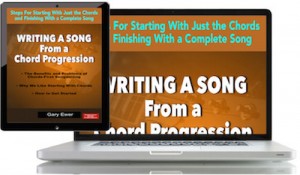When a lead vocal line moves higher, song energy builds in a very natural way.
 ____________
____________
What do you use your iPad for? Why not let it help you improve your songwriting skills? Download “The Essential Secrets of Songwriting” eBook Bundle, and increase your song’s HIT potential. For desktop, laptop, iPad, iPhone, or any other mobile PDF-reading device. Plus get this DISCOUNT.
_____________
 If your song is in verse-chorus format, here’s a little test you can do to see if those verse and chorus melodies are generating a good amount of momentum and energy:
If your song is in verse-chorus format, here’s a little test you can do to see if those verse and chorus melodies are generating a good amount of momentum and energy:
- Write down all the notes you use in the verse, from lowest to highest.
- Write down all the notes you use in the chorus, from lowest to highest.
- Compare the lowest notes of the verse to the lowest you use in the chorus.
- Compare the highest notes of the verse to the highest you use in the chorus, and note how many times those highest notes happen.
There should be a clear difference: the notes you use in your song’s chorus will usually be higher than the ones you use in the verse. The main reason for this is that song energy ramps up when a voice moves higher. It’s a basic principle of songwriting that song energy should increase when you compare the beginning of a verse to the end of a chorus, and moving the voice higher is the easiest and most natural way to do it.
You may find that both your verse and chorus have the same (or almost the same) lowest note, while the upper range is the one that differs, and this is fairly common.
Nothing is ever cast in stone with songwriting, and it is possible to find songs where the verse and chorus sit more-or-less in the same basic range, or even with the chorus lower, as you get in the first verse/chorus of The Doors “Light My Fire”.
But in those cases, the songwriter has likely done other things to increase energy: add instruments that play higher and louder and with more rhythmic intensity, for example. Or, in the case of “Light My Fire”, you’ll find that the words “Come on, baby, light my fire…” are meant to signify relaxation.
If you did the 4 steps above to a classic hit song like The Beatles’ “She Loves You”, you’d get the following. (Upper octave notes are shown with an apostrophe (e.g., G’):
- E-G-A-B-C-D-E’-F#’-G’
- G-A-Bb-E’-F#’-G’
- Verse lowest note: E. Chorus lowest note: G
- Verse highest note: G’ (2 times). Chorus highest note: G’ (4 times)
As you can see, the ranges are similar, with the only significant difference being how often the higher note (G’) happens. And for many songs, that’s the main difference. It’s not so much that the chorus range is dramatically higher, but rather that it sits in the upper range more so than the verse.
As I mentioned, moving the voice higher is the easiest and most natural way to generate song energy. Whether that difference in range is dramatic (“Free Fallin'”, Tom Petty, Jeff Lynne), or subtle as in “She Loves You,” you’ll usually see it.
If you find that your songs just aren’t generating the kind of energy you wish they were, take a look at verse and chorus ranges, and note the following common traits in successful songs from the past several decades:
- A chorus’s range will be significantly higher than the verse range; OR
- A chorus’s range will be slightly higher than the verse, but spend more time around the higher notes; OR
- A chorus’s range will be the same as the verse’s range, but the fuller instrumentation of the chorus will boost song energy; OR
- A chorus’s range will be lower than the verse, but for some reason that becomes obvious in the lyric (as in “Light My Fire”, “No Reply At All” (Genesis))
For songs in a verse-refrain format, like “The Times They Are A-Changin'” (Bob Dylan), you’ll find that the highest notes often occur near the end of the verse, with the refrain starting high and finishing lower.
______________
Written by Gary Ewer. Follow on Twitter.
 “Writing a Song From a Chord Progression” is part of “The Essential Secrets of Songwriting” 10-eBook Deluxe Bundle. That eBook (high-quality PDF format) shows you the best way forward when you write songs that start by creating a chord progression. Read more.
“Writing a Song From a Chord Progression” is part of “The Essential Secrets of Songwriting” 10-eBook Deluxe Bundle. That eBook (high-quality PDF format) shows you the best way forward when you write songs that start by creating a chord progression. Read more.










This post was great Gary thank you!
Pingback: Interesting Links For Musicians and Songwritiers – June 1, 2015 | Creative Music | Inspiring Musical Creativity